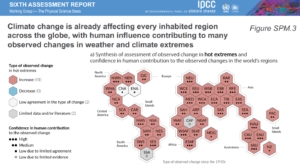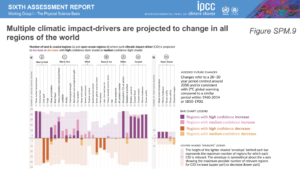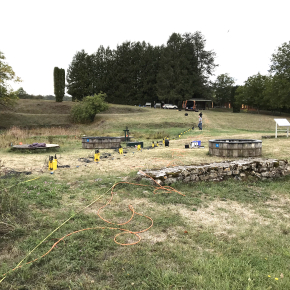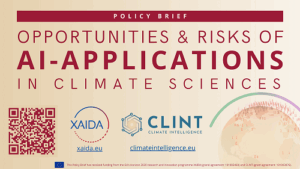IPCC Report: Regions get customized data
Robert Vautard is director of the Institute Pierre-Simon Laplace, a researcher at the LSCE-IPSL and coordinating author of the latest IPCC report. The chapter he coordinates reviews the information researchers have on regional climates and the risks and impacts they face with climate change. This information is crucial for decision-makers to make accurate and effective choices to prepare for and adapt to climate change.

The impacts of climate change are already being observed today across all regions of the globe. This is one of the many statements of the new IPCC report released on the 9th of August, and is well-seen in the image above showing in red the regions where an increase in extreme heat waves has been observed. The report shows with great confidence that temperatures have risen in all continental regions, will continue to rise and faster than the global average. But not all regions are affected in the same way, and the 12th chapter of this Working Group 1 report on the physical science basis emphasises the regional information by presenting the most accurate summary possible. “This is one of the key points of this new report: to provide more information on climate conditions on a smaller scale than in previous reports so that policy-makers can make decisions that are better adapted to their region,” points out Robert Vautard, research director at the CNRS and the Institute Pierre-Simon Laplace and coordinator of this chapter.
Assessing climate change at the regional level is a complex study of the interactions between ‘normal’ internal climate variability and external pressures. The impact of anthropogenic greenhouse gas emissions is attenuated or amplified at the regional level by feedbacks, linked for example to interactions between temperature and drought (one amplifying the other), or temperature and snow or ice cover. It is also modulated by land use and aerosol concentration and is superimposed on decadal and multi-decadal fluctuations.
And climate internal variability is stronger at the regional level than at the global one. There are also uncertainties in observations, models and external pressures, making it more difficult to assess the impact of greenhouse gases, stratospheric ozone and various aerosols. However, the report states that the impact of human activities is a major driver of changes in mean temperatures since 1950 in many sub-continental regions of the world. This impact includes greenhouse gas and aerosol emissions, but also land use and irrigation for example. This new IPCC assessment also specifies that changes in climate impact factors (which affect societies and ecosystems) will be stronger at 2°C than at 1.5°C, and even stronger and more widespread for higher levels of warming. “The objective remains to limit warming to 1.5°C, and if we don’t achieve this we will aim for 1.6°C, which will be better than 1.7°C and so on,” stresses the researcher. Robert Vautard insists that “the crucial point is the reduction of our emissions in the coming decade, which is absolutely fundamental. The actions that will be taken in the coming decade will be decisive for the future”.
With further global warming, every region is projected to increasingly experience concurrent and multiple changes in climatic impact-drivers. Changes in several climatic impact-drivers would be more widespread at 2°C compared to 1.5°C global warming and even more widespread and/or pronounced for higher warming levels – IPCC Summary for Policy Makers
The report states that these mechanisms can also lead to greater temperature extremes compared to average temperatures. For a 2°C warming, these extreme heat waves would reach critical thresholds for health, agriculture and other sectors more frequently by the middle of the 21st century. This information is essential for understanding region-specific risks. The IPCC has made available an interactive online atlas to give everyone the opportunity to take ownership of the data, and to visualise trends at the regional scale. Users can explore data on the past, present and future, with both observations and climate projections. Summary sheets of regional information are also available, as here for Europe.
This new regional information has been made possible by recent advances in climate observations and models. The latest generation of models has a much better resolution (10 km or so), including small-scale climate phenomena, such as the effects of mountain ranges, and the future generation aims for the kilometre scale. This will give access to new phenomena such as storms or phenomena linked to marked topography, coastal or urban effects, or to better specify interactions such as land use and climate, which play an important role in the regional climate and in particular for extreme weather and climate events. But already today, the IPCC report presents a rich assessment of all the regions of our planet and underlines the need for all to prepare for multiple risks.

All regions throughout the globe will need to prepare for multiple impacts.
What is the IPCC ?
Created in 1988 by the World Meteorological Organization (WMO) and the United Nations Environment Programme (UNEP), the objective of the IPCC is to provide governments at all levels with scientific information that they can use to develop climate policies. IPCC reports are also a key input into international climate change negotiations. The IPCC is an organization of governments that are members of the United Nations or WMO. The first working group (WG1) of the six assessment report (AR6) published its assessment on the physical science basis of our climate on the 9th of August 2021. It is the work of 234 international researchers that have analysed the entirety of science literature on the subject. The two following working groups on the AR6 will render their assessment in 2022 respectively on impacts, adaptation and vulnerability and finally mitigation.
To go further:
Get more information on how to improve models resolution with Davide Faranda : Downscaling models: precious need for the regional level
The special case of the Mediterranean Basin with Jan Polcher : The Mediterranean Sea, Hot-spot of climate change
Find out all information and documents on the IPCC last report online on the IPCC website
Access all articles of the series Détour vers le futur – L’IPSL à l’heure du GIEC






